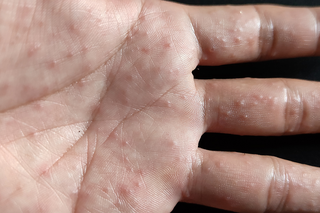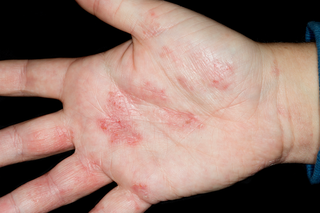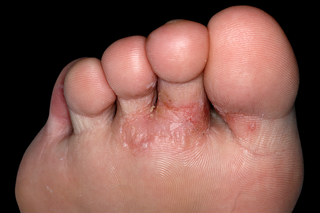Pompholyx (also called dyshidrotic eczema) is a type of eczema that affects the hands or feet. It's usually a long-term condition, but treatment can help control the symptoms.
Check if you have pompholyx
Pompholyx causes itchy blisters on the hands or feet that come and go. The symptoms usually last 2 to 3 weeks at a time.
The first symptom is often a burning or prickling feeling in the affected area.




If you're not sure it's pompholyx
Other conditions can cause sore, itchy patches or blisters on the hands and feet, including hand, foot and mouth disease, psoriasis or athlete's foot.
Do not try to diagnose yourself – see a GP if you're worried.
Non-urgent advice: See a GP if:
- you think you have pompholyx
- you have pompholyx and the blisters are very painful, leak yellow or green pus or are covered in a yellow-brown crust – these are signs of an infection
- you have any other changes to your skin you're worried about
Treatments for pompholyx
Pompholyx is usually a long-term condition that comes and goes over time. Treatment can help control the symptoms.
The main treatments for pompholyx are:
- moisturisers (emollients) – used every day to stop the skin becoming dry
- steroid creams and ointments (topical steroids) – used for a few weeks at a time to reduce irritation and soreness
If the blisters leak fluid, a GP may suggest soaking your skin in potassium permanganate solution. This helps dry the blisters and reduces the risk of them getting infected.
If the blisters become infected, a GP may prescribe antibiotics.
Treatments from a specialist
If your symptoms are severe or treatment is not helping, a GP may refer you to a skin specialist (dermatologist).
A dermatologist may recommend other treatments, such as:
- steroid tablets
- treatment with ultraviolet (UV) light
- other medicines, such as alitretinoin
Things you can do to ease symptoms of pompholyx
If you have pompholyx, your skin may get irritated easily. There are some things you can try to see if they help.
Do
-
wash your hands with warm (not hot or cold) water and use a moisturiser (emollient) soap substitute instead of regular soap
-
wear protective gloves (ideally with a cotton lining) when using chemicals like shampoos, cleansers and detergents
-
wear socks, tights or stockings made from cotton or silk, rather than nylon
-
wear shoes made from leather, rather than plastic or rubber
-
avoid anything you think causes your symptoms, such as cleansers or detergents
Don’t
-
do not burst your blisters
A pharmacist can help with pompholyx
If your skin gets very itchy and it affects your sleep, ask a pharmacist about antihistamines that make you drowsy (sedating antihistamines).
If you take these before going to bed, they can help you get to sleep.
What causes pompholyx
It's not clear exactly what causes pompholyx.
Certain things are thought to cause symptoms in some people, including:
- contact with strong chemicals like soaps, cleansers and detergents
- an allergy or sensitivity to certain metals, such as nickel or cobalt
- getting your hands wet regularly – for example, if you’re a hairdresser
- stress
- heat and sweat
If you notice something causes your symptoms, avoiding it as much as possible may help keep your symptoms under control.
Page last reviewed: 02 March 2022
Next review due: 02 March 2025